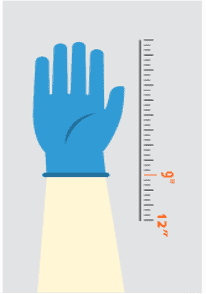When it comes to choosing the correct glove for the job, the texture is crucial. It starts on the glove molds during the manufacturing process. Sandblasting, which employs ceramic balls and pressured air to generate texture on the surface, and spray-on, which directly applies a coating, are the two methods used to create roughened and micro-roughened textures. The methods are fundamentally the same, but the patterns and client preferences are different. On thicker gloves, sandblasting is utilized, and on thinner gloves, a spray-on is employed. Gloves can be textured everywhere; on the fingers, the fingertips, the inner palm and fingers, or both sides. Ambidextrous gloves, as most disposable gloves are, are textured on both sides. Gloves with textured surfaces provide a better grip. The textures range from micro-roughening for basic needs to an aggressive raised diamond texture that directs liquids away from the grip even when the gloves are wet.
Smooth:
Most of these gloves are composed of vinyl and have no texture. They are also ideal for tasks where a precise grasp isn’t required, such as salon care, food preparation, and food service.
Textured:
They are mostly used for nitrile and latex gloves. In fact textured nitrile gloves account for 95% of all nitrile gloves. The surface seems to be lightly sanded. And, they’re ideal for medical applications since they provide a better grip for handling equipment and small objects without having an exaggerated surface that could irritate patients.
Diamond:
They are the disposable gloves with the strongest texture. Because the raised diamonds of this pattern have channels between them that allow liquids to move through, allowing for more surface contact and improved grip. For example, the raised diamond texture is great for holding wet or slippery small objects and tools. However, gloves with a rough texture demand more material, so they’re thicker and more protective. As a result, these gloves are most suited to automotive and manufacturing applications, with lesser use in medical situations.





